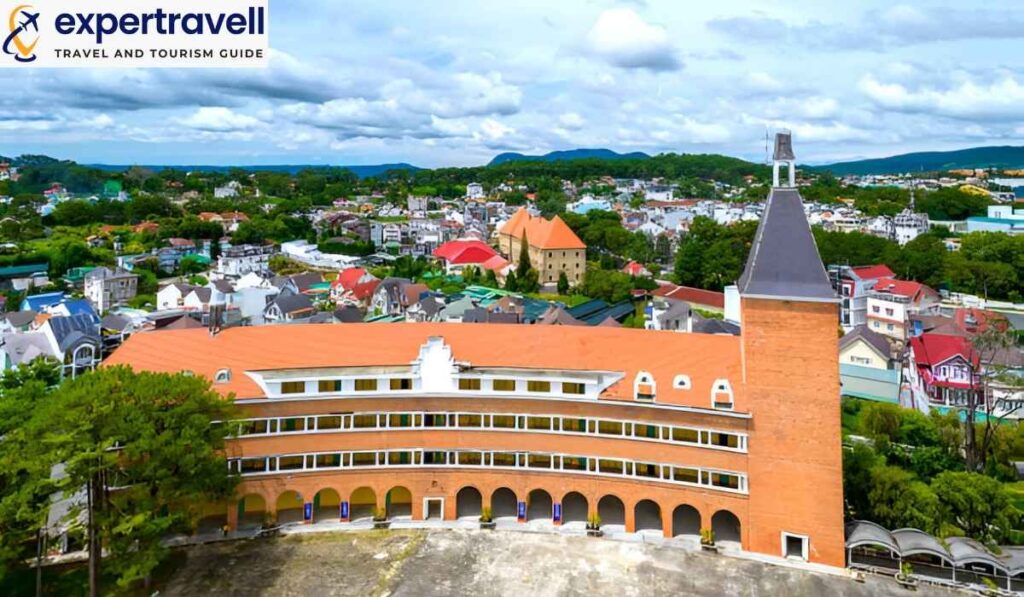Lisbon, the capital of Portugal, is a city that captivates visitors with its charm and beauty. It sits on seven hills overlooking the Rio Tejo, creating a stunning backdrop of cobbled streets, ancient ruins, and white-domed cathedrals. Lisbon has become a trendy city break destination, known for its laid-back atmosphere and sunny climate.
The city offers a perfect blend of history and modernity. Visitors can explore centuries-old neighborhoods, marvel at architectural wonders, and enjoy a vibrant food scene. Lisbon’s rich cultural heritage is evident in its museums, monuments, and traditional fado music.
Planning a trip to Lisbon is easy with the right information. From choosing the best time to visit to finding top attractions and hidden gems, a good travel guide can help make the most of your Portuguese adventure. Whether you’re interested in sightseeing, trying local cuisine, or soaking up the sun on nearby beaches, Lisbon has something for everyone and is one of the best places to travel for beginners.
Best Time To Visit Lisbon
Lisbon enjoys a Mediterranean climate with mild winters and warm summers. The city’s weather patterns and tourist seasons greatly influence the ideal time for a visit.
Weather By Season
Spring
(15°C to 22°C/59°F to 72°F) offers pleasant weather, ideal for outdoor activities and sightseeing.
Summer
Hot and dry, often over 30°C (86°F), with crowds and higher prices.
Autumn
(15°C to 25°C/59°F to 77°F) brings cooler weather and fewer tourists.
Winter
Mild, rarely below 10°C (50°F), but can be rainy.
Best Time to Visit
May and September are the best months for a balance of pleasant weather and fewer crowds.
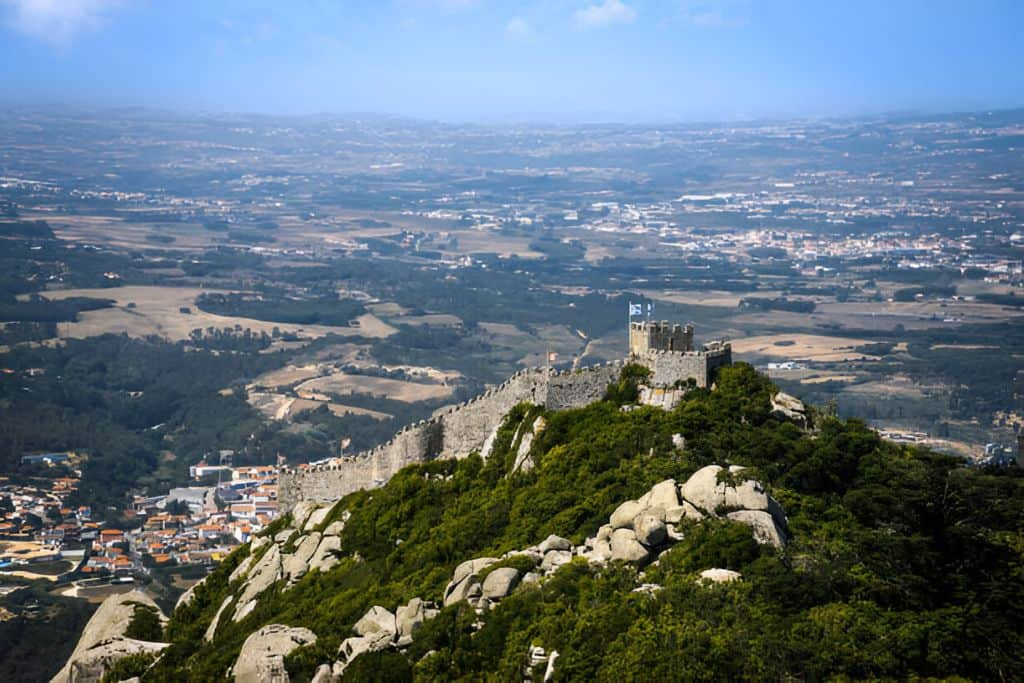
Top Attractions In Lisbon
Lisbon boasts many iconic landmarks and hidden gems. From historic towers to bustling squares, the city offers a mix of cultural and architectural wonders, along with countless unique things to do.
Belém Tower
The Belem Tower stands as a symbol of Portugal’s Age of Discovery. Built in the 16th century, this UNESCO World Heritage site served as a fortress and lighthouse. Its Manueline architecture features intricate stonework and maritime motifs. Visitors can climb the narrow stairs for panoramic views of the Tagus River. The tower’s location by the water makes it a popular spot for photos. Inside, tourists can explore different levels, including the Governor’s Hall and King’s Hall. The terrace offers stunning vistas of Belém and the nearby Jerónimos Monastery.
Jeronimos Monastery
This grand monastery is another UNESCO World Heritage site. It showcases elaborate Manueline architecture with maritime elements. The monastery was built to honor Portugal’s Age of Discovery. Its cloisters feature intricate stone carvings and serene gardens. The Church of Santa Maria houses the tomb of explorer Vasco da Gama. Visitors can tour the monks’ dormitories and refectory. The monastery also houses two museums: the National Archaeology Museum and the Maritime Museum.
Sao Jorge Castle
Perched atop a hill, São Jorge Castle offers sweeping views of Lisbon. This Moorish castle dates back to the 11th century and played a key role in the city’s history. Visitors can walk along the castle walls and explore its 11 towers. The Camera Obscura in the Tower of Ulysses provides a 360-degree view of Lisbon. The castle grounds include peacocks, gardens, and archaeological sites. An on-site museum displays artifacts found during excavations.
Praca do Comercio
This vast square faces the Tagus River and serves as Lisbon’s main plaza. It’s flanked by yellow buildings and arcades housing cafes and shops. The square’s centerpiece is the statue of King José I on horseback. The Arco da Rua Augusta, a triumphal arch, marks the northern entrance. Visitors can climb the arch for city views or enjoy outdoor dining in the square. The area comes alive with events and performances throughout the year.
LX Factory
Once an industrial complex, LX Factory now buzzes with creative energy. This hip area houses trendy shops, cafes, and art spaces. Visitors can browse unique boutiques or sample local cuisine at various eateries. The Sunday market offers vintage goods and artisanal products. Street art adorns many buildings, adding to the area’s artistic vibe. LX Factory also hosts cultural events and exhibitions regularly.
Miradouros
Lisbon’s hilltop viewpoints, or miradouros, offer breathtaking city vistas. These spots provide perfect photo opportunities and peaceful retreats. Miradouro Santa Luzia features a terrace with azulejo panels and views of Alfama. Miradouro da Senhora do Monte offers panoramic views of the castle and downtown. Miradouro de São Pedro de Alcântara boasts manicured gardens and a unique perspective of the city. Many miradouros have kiosks serving drinks and snacks, perfect for enjoying the scenery.
Things to Do in Lisbon, Portugal
- Explore São Jorge Castle: Enjoy panoramic views of the city and its history.
- Visit Belém Tower: A UNESCO World Heritage Site and iconic Lisbon landmark.
- Stroll through Alfama: Wander the narrow streets of this traditional neighborhood.
- Ride Tram 28: A scenic route through historic districts.
- Discover Jerónimos Monastery: Another UNESCO site showcasing stunning architecture.
- Experience Fado Music: Enjoy live Fado performances in local bars and restaurants.
- Relax at Praça do Comércio: A grand square by the Tagus River.
- Visit the Time Out Market: Sample local food and drinks from Lisbon’s top chefs.
- Take a Day Trip to Sintra: Explore its beautiful palaces and gardens.
- Check Out LX Factory: A creative hub filled with shops, galleries, and cafes.
Neighborhoods To Explore In Lisbon
Lisbon’s diverse neighborhoods offer a mix of history, culture, and charm. From winding cobblestone streets to stunning views, each area has its unique character.
Alfama
Alfama is Lisbon’s oldest neighborhood. Its narrow streets and colorful houses create a maze-like atmosphere. Visitors can enjoy traditional Fado music in local venues. The area is full of small shops and cafes. Many buildings have beautiful azulejo tiles on their facades. Alfama offers amazing views of the city from its many viewpoints. The São Jorge Castle sits at the top of the hill, providing a glimpse into Lisbon’s past.
Baixa
Baixa is the downtown area of Lisbon. It has wide avenues and grand squares. The neighborhood was rebuilt after the 1755 earthquake. Shops and restaurants line the streets. The main square, Praça do Comércio, faces the Tagus River. Baixa is home to many historic buildings. The Santa Justa Lift offers panoramic views of the city.

Bairro Alto
Bairro Alto is known for its vibrant nightlife. During the day, it’s a quiet residential area. At night, it comes alive with bars and restaurants. The neighborhood has a bohemian feel. Street art adorns many walls. Small boutiques sell unique items. Bairro Alto sits on a hill, offering great views of the city below.
Chiado
Chiado is Lisbon’s elegant shopping district. It’s full of high-end stores and historic cafes. The area is home to several theaters and museums. The famous Café A Brasileira is a popular spot for coffee. Chiado has a mix of old and new architecture. The ruins of the Carmo Convent offer a glimpse into the past.
Belém
Belém is known for its historic monuments. The Belém Tower and Jerónimos Monastery are UNESCO World Heritage sites. The neighborhood is famous for pastéis de Belém, a delicious custard tart. The original bakery still uses a secret recipe. Belém has several museums, including the National Coach Museum. The area along the Tagus River offers great spots for walks.
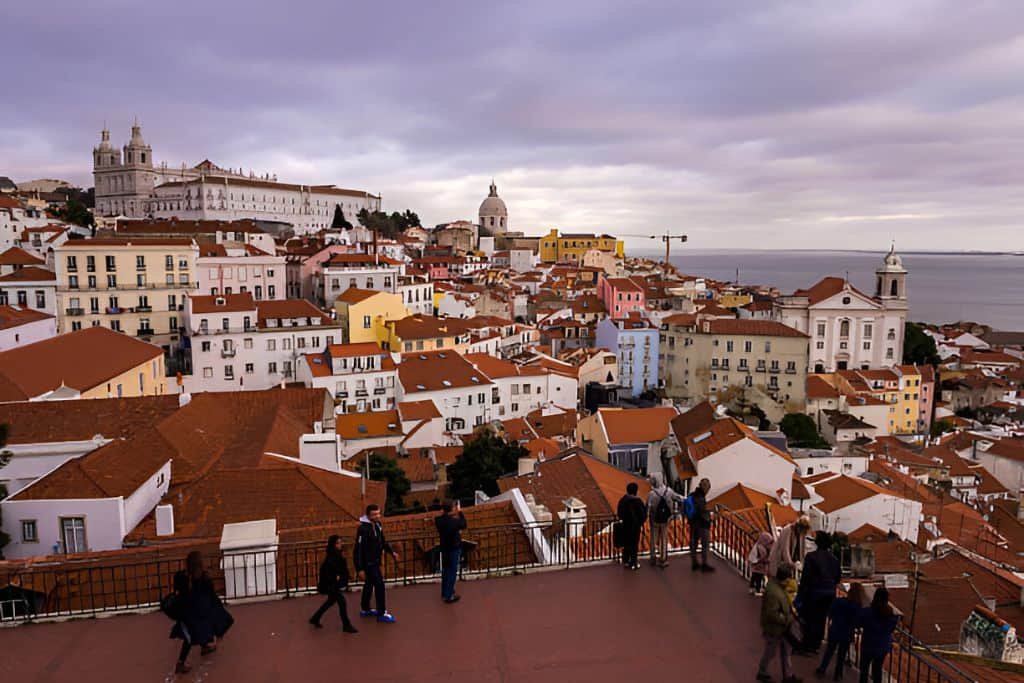
Cultural Experiences In Lisbon
Lisbon offers a rich tapestry of cultural experiences. Visitors can immerse themselves in the city’s soulful music, explore world-class museums, and join lively traditional celebrations.
Fado Music
Fado, Portugal’s heart-stirring folk music, is a must-experience in Lisbon. This expressive musical style originated in the city’s working-class neighborhoods. Visitors can enjoy fado performances in intimate venues called casas de fado. These small clubs often combine dinner with live music shows. Popular areas to hear fado include the Alfama and Bairro Alto districts. Some well-known fado houses are Clube de Fado and Parreirinha de Alfama. For a deeper dive into Fado’s history, the Fado Museum in Alfama is worth a visit. It showcases instruments, costumes, and audio exhibits.
Must-See Museums
Lisbon boasts numerous museums covering art, history, and culture. The Museu Coleção Berardo in Belém is a top spot for modern and contemporary art fans. It features works by Picasso, Warhol, and Dali. The National Tile Museum offers a unique look at Portugal’s azulejo tile tradition. It’s housed in a stunning 16th-century convent. For history buffs, the National Museum of Ancient Art holds an impressive collection of European and Asian art from the 14th to early 19th centuries. The Calouste Gulbenkian Museum is another gem. It displays a diverse collection of ancient and modern art in a tranquil setting.
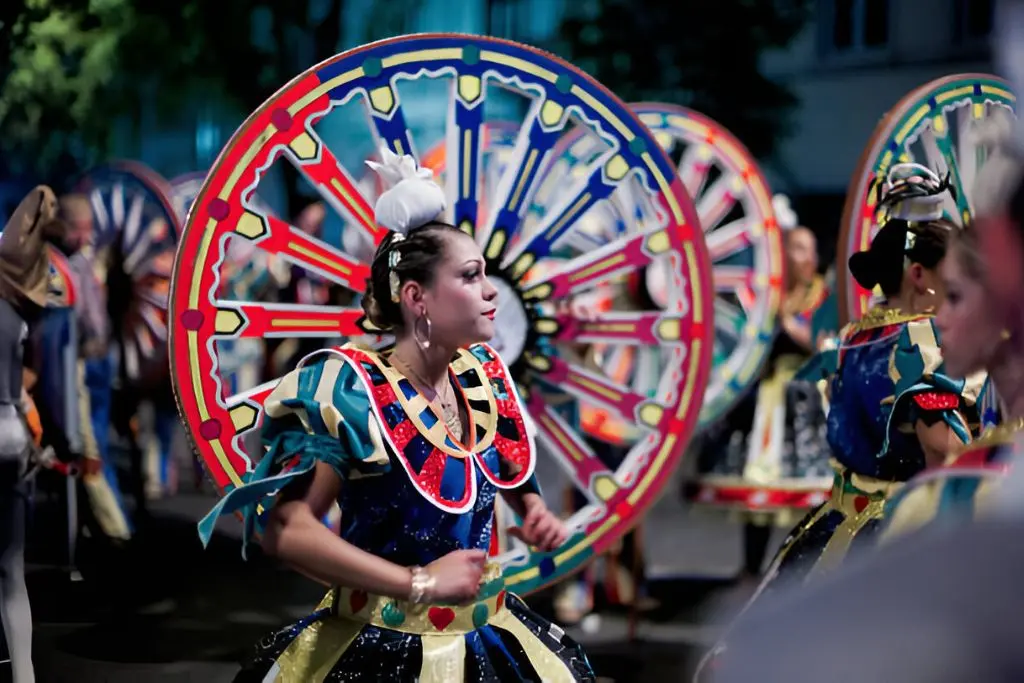
Traditional Festivals
Lisbon’s calendar is packed with vibrant festivals celebrating Portuguese culture. The Festas de Lisboa in June is the city’s biggest party. It features parades, music, and street food. Santo António Festival, also in June, honors Lisbon’s patron saint. Expect sardine grilling contests, folk dancing, and colorful street decorations. For film enthusiasts, the Lisbon & Sintra Film Festival in November showcases international cinema. It includes screenings, workshops, and talks with filmmakers. The Lisbon Fish and Flavors festival in April is a food lover’s delight. It highlights Portugal’s seafood cuisine with cooking demos and tasting events.
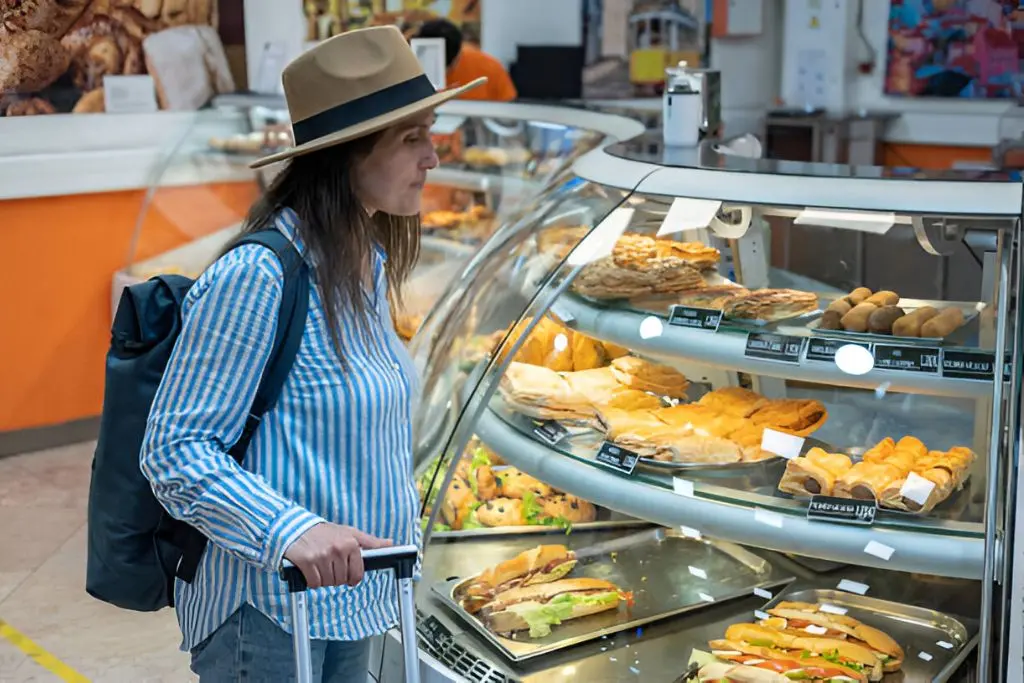
Food And Drink In Lisbon
Lisbon’s food scene offers a mix of traditional Portuguese dishes and modern culinary innovations. From fresh seafood to sweet pastries, the city’s cuisine reflects its rich history and coastal location.
Must-Try Portuguese Dishes
- Salted cod is a staple, served grilled, baked, or in fritters.
- Sardines are popular, especially during summer festivals.
- Portuguese stew is a hearty dish with meats and vegetables.
- Kale soup is a great option for vegetarians.
- Custard tarts are famous in Lisbon, best enjoyed fresh with cinnamon.
- Quick snacks include pork sandwiches and beef sandwiches.

Best Local Restaurants and Cafés
- Ramiro: Known for fresh seafood like prawns and lobster.
- A Cevicheria: Offers a modern twist on Portuguese cuisine with ceviche.
- A Brasileira Café: A historic spot perfect for coffee and people-watching.
- Time Out Market: A popular food hall showcasing local chefs.
- Fauna & Flora: A favorite for plant-based options and trendy decor.
Food Markets
- Ribeira Market: Part of Time Out Market, with a mix of traditional and modern food options.
- Campo de Ourique Market: A smaller, less touristy market for local specialties.
- Alvalade Market: A neighborhood market offering fresh fish, meats, and produce.
- Try cherry liqueur, a unique Lisbon treat sold at small storefronts.
Getting Around Lisbon
Lisbon offers many ways to explore its vibrant streets and neighborhoods. Visitors can use public transit, walk, or cycle to see the city’s sights.
Public Transportation
Lisbon has a well-connected public transport system, including buses, trams, metro, and trains. The metro covers much of the city, while trams, especially the historic yellow ones, are a popular way to explore. A 24-hour ticket for €6.60 offers unlimited travel on buses, trams, and metro, and a €10.70 option includes trains to Cascais and Sintra. Taxis, Ubers, and tuk-tuks provide convenient but more expensive alternatives.
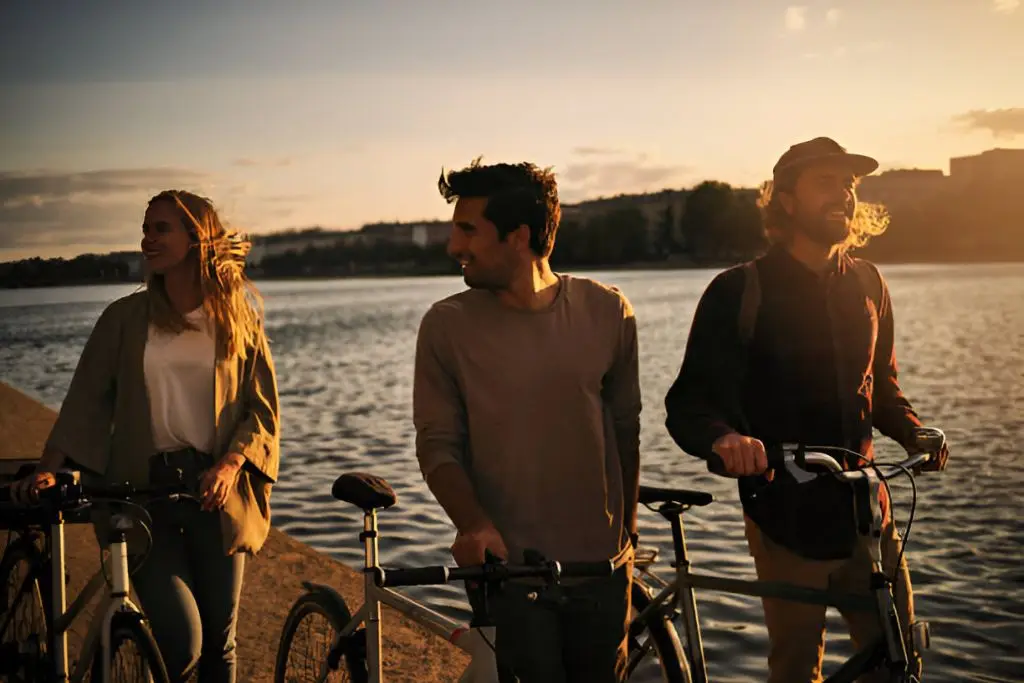
Walking and Cycling
Walking is a great way to explore Lisbon’s neighborhoods and scenic spots like Avenida Ribeira das Naus. While the city is hilly, the views are rewarding. Cycling is also an option, with growing bike lanes and electric scooters available for rent.
Day Trips From Lisbon
Lisbon offers easy access to stunning destinations nearby. These trips let you explore historic sites, beautiful beaches, and charming towns.
Sintra
A magical town with colorful palaces and castles, such as the vibrant Pena Palace and the Castle of the Moors, offering stunning views. Don’t miss the Quinta da Regaleira with its hidden tunnels and wells. Easily accessible from Lisbon by a 40-minute train ride.

Cascais
A charming coastal town known for its beautiful beaches like Praia da Conceição and Praia da Rainha. Explore the Castro Guimaraes Museum and Boca do Inferno for dramatic sea views. Great for water activities like surfing and sailing.
Évora
A historic city in the Alentejo region, famous for the Temple of Diana and the eerie Chapel of Bones. Évora’s old town is a UNESCO site, and visitors can enjoy traditional food and wine in its lively atmosphere.
Where To Stay In Lisbon
Lisbon offers diverse accommodation options to suit every traveler’s needs and budget. From charming neighborhoods to luxurious hotels, the city has something for everyone, whether you’re staying for a week or just passing through, like spending one day in Cozumel.
Best Neighborhoods for Tourists
- Bairro Alto: Lively area is known for nightlife, bars, and restaurants.
- Baixa: Central location with historic buildings and easy access to main attractions.
- Alfama: Traditional district with narrow streets and Fado music venues.
- Avenida da Liberdade: Ideal for luxury shopping and high-end hotels.
Budget-Friendly and Mid-Range Accommodations
- Hostels: Popular among budget travelers for affordable stays and social atmosphere.
- Airbnb: Mid-range option in local neighborhoods for a more authentic experience.
- Guesthouses: Affordable options in Graça and Príncipe Real offer good value.
- Mama Shelter: Trendy mid-range hotel with fun decor and an outdoor terrace.

Luxury Hotels
- Four Seasons Hotel Ritz: Top luxury choice with elegant rooms and fine dining.
- Bairro Alto Hotel: Central luxury hotel with a rooftop bar and city views.
- Olissippo Lapa Palace: 19th-century palace with gardens and a pool.
- Memmo Príncipe Real: Boutique hotel blending modern design with Portuguese charm.
Shopping In Lisbon
Lisbon offers diverse shopping experiences, from upscale boutiques to bustling markets. Visitors can find unique Portuguese products, fashion, and local crafts throughout the city.
Chiado and Avenida da Liberdade
Chiado is a trendy shopping district with a mix of high-end and affordable stores. Avenida da Liberdade features designer boutiques for fashion enthusiasts. Shoppers can find Portuguese-made goods at A Vida Portuguesa, and enjoy tax-free shopping for non-EU residents.
Local Markets
Feira da Ladra, a popular flea market, offers antiques and handmade crafts. Mercado da Ribeira provides fresh food and a variety of dining options. The Meeting Room showcases local designers and unique fashion items.
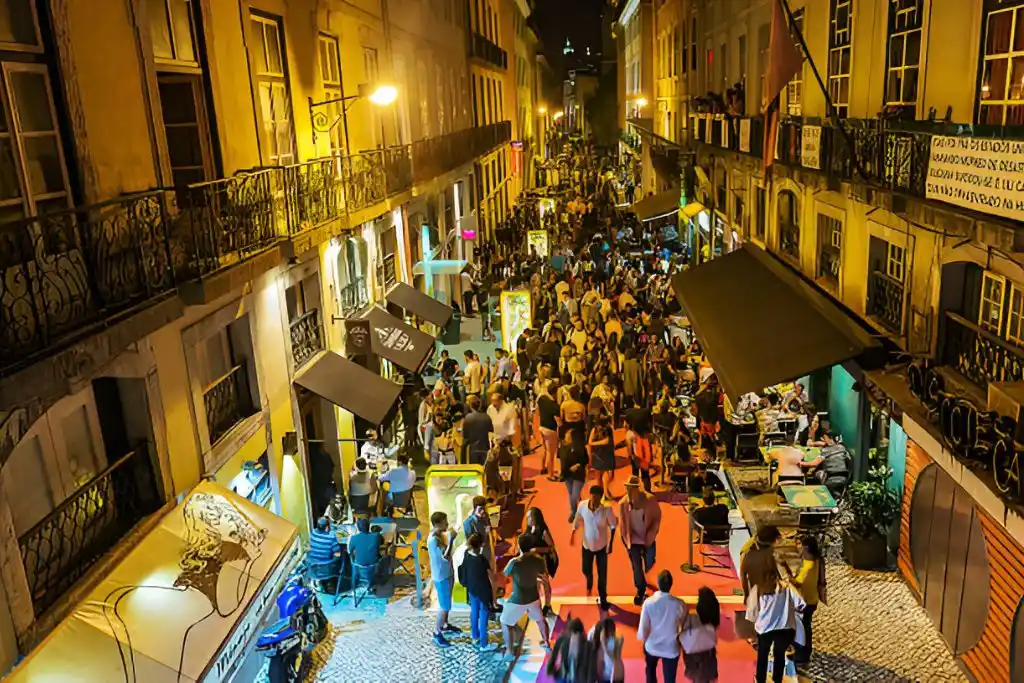
Nightlife In Lisbon
Lisbon comes alive after dark with vibrant bars and clubs. The city offers a mix of traditional and modern nightlife experiences, from historic neighborhoods to trendy rooftop venues.
Bairro Alto
Bairro Alto is Lisbon’s nightlife hub, buzzing with bars and party-goers after sunset. Popular spots include Gin Lovers for creative gin cocktails and Foxtrot for live music. Mini Bar by chef José Avillez offers cocktails and gourmet snacks, perfect for starting the night.
Rooftop Bars
Lisbon’s rooftop bars offer incredible views. Park Rooftop is a hidden gem with a relaxed vibe, while Java Rooftop Bar provides craft cocktails and stunning sunset views. Ferroviario near the Tagus River offers a beachside club atmosphere popular with both locals and tourists.

Lisbon For Families
Lisbon is perfect for family travel, with plenty of kid-friendly activities. Jardim de Estrela offers playgrounds and a relaxing park for families. The Pavilhão do Conhecimento is a hands-on science museum kids love. Lisbon’s famous yellow trams provide fun city tours, while the Oceanarium is a must-visit for animal lovers. Many attractions offer free entry for young children, and the warm climate makes outdoor activities enjoyable year-round. Beaches and family-friendly restaurants, like those serving pastéis de nata, complete the experience.
Travel Tips For First-Time Visitors
Lisbon welcomes visitors with open arms. A few key tips will help you make the most of your trip and avoid common pitfalls.
Local Customs and Etiquette
- Greet with “Olá” or “Bom dia.”
- Finish your plate when dining, and tipping (5-10%) is appreciated.
- Dress modestly in churches (cover shoulders and knees).
- Public displays of affection are generally accepted but be discreet in conservative areas.
Safety Tips and Common Tourist Scams
- Watch out for pickpockets in crowded areas and on public transport.
- Avoid fake drug dealers and unlicensed taxis; use official cabs or ride-sharing apps like Uber.
- Be wary of “free” gifts or bracelet scams—decline politely and walk away.
Useful Portuguese Phrases
Learning a few basic phrases shows respect and can enhance your experience.
- Obrigado/Obrigada – Thank you (male/female)
- Por favor – Please
- Desculpe – Excuse me
- Fala inglês? – Do you speak English?
- Onde está…? – Where is…?
- A conta, por favor – The bill, please
Many locals speak English, especially in tourist areas. But attempting Portuguese is appreciated. Free WiFi is available in many public spaces and cafes. Prices in Lisbon are reasonable compared to other European capitals.
Frequently Asked Questions
What are the top attractions to visit in Lisbon?
Lisbon’s must-see attractions include São Jorge Castle, Belém Tower, and Jerónimos Monastery. Don’t miss the Alfama district and Praça do Comércio.
Which Lisbon neighborhoods are a must-see for first-time visitors?
Bairro Alto for nightlife, Chiado for shopping, Baixa for elegant squares, and Príncipe Real for trendy boutiques and gardens.
Where can one find authentic Portuguese cuisine in Lisbon?
Try local tascas in Alfama and Bairro Alto. Don’t miss Time Out Market, pastéis de nata from Pastéis de Belém, and seafood in Cais do Sodré.
How should one navigate public transportation in Lisbon?
Lisbon offers buses, trams, and the metro. The Lisbon Card provides unlimited access. Tram 28 is a scenic option through historic areas.
What are the recommended day trips from Lisbon?
Visit Sintra for palaces, Cascais for beaches, Óbidos for a medieval vibe, and Fátima for a religious pilgrimage.
Can you provide tips for budget-friendly travel in Lisbon?
Visit museums on free entry days, take walking tours, eat at local markets, and use public transportation for affordable travel.



